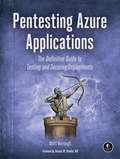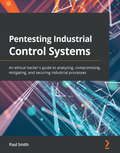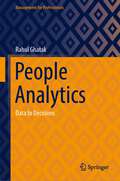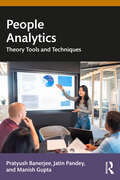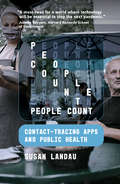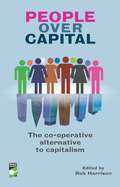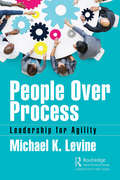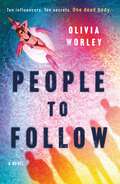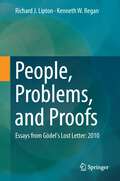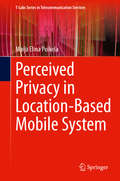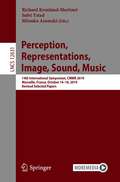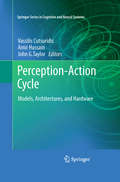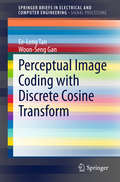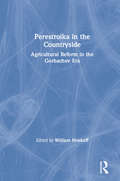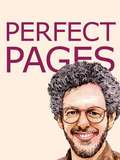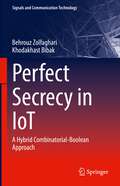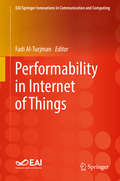- Table View
- List View
Pentesting Azure Applications: The Definitive Guide to Testing and Securing Deployments
by Matt BurroughA comprehensive guide to penetration testing cloud services deployed with Microsoft Azure, the popular cloud computing service provider used by companies like Warner Brothers and Apple.Pentesting Azure Applications is a comprehensive guide to penetration testing cloud services deployed in Microsoft Azure, the popular cloud computing service provider used by numerous companies. You'll start by learning how to approach a cloud-focused penetration test and how to obtain the proper permissions to execute it; then, you'll learn to perform reconnaissance on an Azure subscription, gain access to Azure Storage accounts, and dig into Azure's Infrastructure as a Service (IaaS).You'll also learn how to:- Uncover weaknesses in virtual machine settings that enable you to acquire passwords, binaries, code, and settings files- Use PowerShell commands to find IP addresses, administrative users, and resource details- Find security issues related to multi-factor authentication and management certificates- Penetrate networks by enumerating firewall rules- Investigate specialized services like Azure Key Vault, Azure Web Apps, and Azure Automation- View logs and security events to find out when you've been caughtPacked with sample pentesting scripts, practical advice for completing security assessments, and tips that explain how companies can configure Azure to foil common attacks, Pentesting Azure Applications is a clear overview of how to effectively perform cloud-focused security tests and provide accurate findings and recommendations.
Pentesting Industrial Control Systems: An ethical hacker's guide to analyzing, compromising, mitigating, and securing industrial processes
by Paul SmithDiscover modern tactics, techniques, and procedures for pentesting industrial control systemsKey FeaturesBecome well-versed with offensive ways of defending your industrial control systemsLearn about industrial network protocols, threat hunting, Active Directory compromises, SQL injection, and much moreBuild offensive and defensive skills to combat industrial cyber threatsBook DescriptionThe industrial cybersecurity domain has grown significantly in recent years. To completely secure critical infrastructure, red teams must be employed to continuously test and exploit the security integrity of a company's people, processes, and products. This pentesting book takes a slightly different approach than most by helping you to gain hands-on experience with equipment that you'll come across in the field. This will enable you to understand how industrial equipment interacts and operates within an operational environment.You'll start by getting to grips with the basics of industrial processes, and then see how to create and break the process, along with gathering open source intel to create a threat landscape for your potential customer. As you advance, you'll find out how to install and utilize offensive techniques used by professional hackers. Throughout the book, you'll explore industrial equipment, port and service discovery, pivoting, and much more, before finally launching attacks against systems in an industrial network.By the end of this penetration testing book, you'll not only understand how to analyze and navigate the intricacies of an industrial control system (ICS), but you'll also have developed essential offensive and defensive skills to proactively protect industrial networks from modern cyberattacks.What you will learnSet up a starter-kit ICS lab with both physical and virtual equipmentPerform open source intel-gathering pre-engagement to help map your attack landscapeGet to grips with the Standard Operating Procedures (SOPs) for penetration testing on industrial equipmentUnderstand the principles of traffic spanning and the importance of listening to customer networksGain fundamental knowledge of ICS communicationConnect physical operational technology to engineering workstations and supervisory control and data acquisition (SCADA) softwareGet hands-on with directory scanning tools to map web-based SCADA solutionsWho this book is forIf you are an ethical hacker, penetration tester, automation engineer, or IT security professional looking to maintain and secure industrial networks from adversaries, this book is for you. A basic understanding of cybersecurity and recent cyber events will help you get the most out of this book.
People Analytics: Data to Decisions (Management for Professionals)
by Rahul GhatakThis book is an exploration of the people analytics possibility, bringing out both theoretical frameworks and detailed practical case studies from the author's experience in industry and business across both sides of the table, with an understanding of data science models and SMAC (Social, Mobile & Cloud) technologies underpinning it. It further explores and lays out a business case for why organizations need to invest behind this space and why HR functions and businesses need to embrace and adopt it. The book examines how people analytics makes a difference to business, describes stages of adoption and maturity models for its effective deployment in organizations and explores the journey from employee master data management and conversion to reporting and visualizations to dash-boarding and descriptive analytics, operational analytics to finally predictive modelling. The book provides insights on the impact of big data and social networks on HR and talent frameworks and the opportunity for HR to mine these networks with a view to culling out predictive insights for the business. It also describes in great detail the specific applications of people and talent analytics through case examples. The book discusses and makes the case for HR to be metric driven focused on business outcomes. It enumerates upon “lead” and “lag” indicators and the need to leverage relevant measurement systems. It provides an understanding of relevant statistical tools that could be deployed to mine key insights from the data to enable robust decision-making, and examines the power of “visual intelligence” and data representation that goes beyond traditional tools like Excel. This book is for HR practitioners who seek to challenge the status quo. It does so by helping them leverage a data and evidence based approach; asking the right questions and building new capabilities with a view towards leading change and driving transformation both in their domain, the wider business and the larger organization. The book is also useful for HRM students to gain a deep understanding of “people analytics” as a critical sub-domain within HR. “HR is not just about people but now also about Tech, Data and Analytics. Upgrading numerical/analytics skills in order to have greater impact on the business, is the new wave of HR, which Rahul helps address via his own rich experience.”- Gurprriet Siingh, Managing Director, Russell Reynolds Associates, Mumbai, India. “This book would help HR & Leadership Teams find a way of discarding perceptions and uncovering truth by embracing data patterns as opposed to just continuing with incremental changes to how it has always been. This is particularly so of successful organizations.”- Vikas Gupta, Divisional Chief Executive Officer, Education and Stationery Products Business, ITC Limited, Gurugram, India.
People Analytics: Theory, Tools and Techniques
by Manish Gupta Pratyush Banerjee Jatin PandeyThis book addresses the topic of people analytics focusing especially on demystifying analytics for managers, from both statistical and computing points of view. It presents the evolution and the importance of people analytics in today’s workforce management and highlights the motivation for studying business analytics, shows the different levels of analytic maturity and discusses real world success stories of business analytics in action through case studies. The volume provides the readers with a step-by-step guide to analyze data and interpret the results for strategy formulation. Each chapter of the book includes a vignette, data-driven exercises provided in a companion website, and real-world case studies. The authors also introduce the readers to data visualization software Microsoft Power BI as well as elaborates on how to use Tableau Desktop.This book would be useful to the students of human resource management, organizational behaviour, marketing management, business research methods, applied psychology, social work and sociology. It would also serve as very good handbook for practicing business executives helping them to implement data analytics for effective decision making in all kinds of business situations around the world.
People Analytics: Using data-driven HR and Gen AI as a business asset
by Cole NapperHow can you use people analytics to drive business performance? Why does a data-driven approach to HR add value and how can you achieve this? What role should AI play in a people analytics function?People Analytics has the answers. It is a practical guide for all mid-career HR professionals which explains how data, analysis and effective use of artificial intelligence can drive business performance and be built into every role. It outlines every aspect of people analytics and explains how to use each element to add value in all parts of the business. There is also detailed discussion of the potential gains that can be made through the use of effective integration of people analytics and generative AI. This book offers guidance on how to build the data infrastructure for HR, the importance of high-quality data and step-by-step advice on how to analyse people data confidently so that you can improve business performance. There is also essential discussion of the ethics of using people analytics and artificial intelligence at work and real-world examples from companies including Toyota, PepsiCo, Lightcast, Booster and FedEx. Written by a leading voice in the people analytics space, this is essential reading for all HR professionals needing to understand the power of people analytics.
People Count: Contact-Tracing Apps and Public Health
by Susan LandauAn introduction to the technology of contact tracing and its usefulness for public health, considering questions of efficacy, equity, and privacy.How do you stop a pandemic before a vaccine arrives? Contact tracing is key, the first step in a process that has proven effective: trace, test, and isolate. Smartphones can collect some of the information required by contact tracers--not just where you've been but also who's been near you. Can we repurpose the tracking technology that we carry with us--devices with GPS, Wi-Fi, Bluetooth, and social media connectivity--to serve public health in a pandemic? In People Count, cybersecurity expert Susan Landau looks at some of the apps developed for contact tracing during the COVID-19 pandemic, finding that issues of effectiveness and equity intersect. Landau explains the effectiveness (or ineffectiveness) of a range of technological interventions, including dongles in Singapore that collect proximity information; India's biometric national identity system; Harvard University's experiment, TraceFi; and China's surveillance network. Other nations rejected China-style surveillance in favor of systems based on Bluetooth, GPS, and cell towers, but Landau explains the limitations of these technologies. She also reports that many current apps appear to be premised on a model of middle-class income and a job that can be done remotely. How can they be effective when low-income communities and front-line workers are the ones who are hit hardest by the virus? COVID-19 will not be our last pandemic; we need to get this essential method of infection control right.
People Over Capital
by Rob HarrisonCapitalism is failing and ordinary people are forced to pay the price. With such deep-rooted problems there is real hunger for alternative ways of organizing our economic system. Answering the question, "Is there a co-operative alternative to capitalism?" this book showcases fourteen responses from economists, academics, co-operators, politicians, and campaigners, exploring both the success and untapped potential of co-operatives. Each essay approaches from a new direction-from the flourishing open source movement to cases of co-operative success in different parts of the world.Rob Harrison has written and commented widely on social change issues for more than twenty years.
People Over Process: Leadership for Agility
by Michael K. LevineThis book is about improving and sustaining agility by focusing on people over process, as the first agile value advocates, and is the third and final book in the author's Lean and Agile Software trilogy. The first – A Tale of Two Systems: Lean and Agile Software Development for Business Leaders – describes what agile is and why we do it. The second – A Tale of Two Transformations: Bringing Lean and Agile Software Development to Life – guides leaders in transforming their organizations to adopt this approach. All three books mix description and elaboration of theory with practical demonstration in fictional companies and projects. This new, third book – People over Process: Leadership for Agility – presents a model of facilitative leadership for agility, which informs the entire book. It begins by describing the roots of the agile movement, which motivates the centrality of people and the need for leadership. The leadership model is then presented, very simply: rigor, alignment, efficiency, through frameworks. Leadership is considered for all team members, and then for the special case of the responsibilities of leaders in formal positions of organizational authority. With this strong background presented, the book proceeds to describe and demonstrate common and highly useful frameworks for agility. The fictional Pacifica Bank is introduced, and we see the Pacifica team work through architecture, project planning, team structure, governance, scrum meeting, and ultimately retrospectives, using frameworks that have been presented. An Appendix summarizes the most useful frameworks for future reference. Throughout the book concepts are illustrated with vignettes from my experience (in the didactic sections) and with the Pacifica fictional case study. The key benefits of the book are to make everyone involved in agile work more effective and fulfilled. Essentially, since agile was first introduced almost two decades ago, the primary focus in practice has been on process. The "scrum" methodology was developed and promulgated, and has been widely adopted. This has been on balance broadly positive, but as an industry we have progressed to the point where following the steps of a methodology, particularly one that seeks to implement concepts where the first value is "People over Process," has reached its limits. The reader of this book: • Gains a powerful, simple model of leadership that enables the "People" in "People over Process;" • Sees these principles in action in a fictional company, making agile leadership understandable and engaging; • Improves their ability to participate in and lead agility; • Learns extraordinarily useful "frameworks" that help in the most important activities in agile software. In short, the reader will be better at delivering valuable software solutions, more valuable to their organizations, and more fulfilled in their work.
People to Follow: A Novel
by Olivia WorleyIn Olivia Worley's pitch-perfect debut, People to Follow, ten teen influencers come to a remote island to star in a reality show, but when one of them winds up dead, they realize that this time, the price of getting “cancelled” could be their lives.A reality show on a remote Caribbean island. Ten teen influencers. One dead body.Welcome to “In Real Life,” the hot new reality show that forces social media’s reigning kings and queens to unplug for three weeks and “go live” without any filters. IRL is supposed to be the opportunity of a lifetime, watched closely by legions of loyal followers. But for these rising stars--including Elody, an Instagram model with an impulsive streak; Kira, a child star turned fitness influencer; Logan, a disgraced TikTok celeb with a secret; and Max, a YouTuber famous for exposés on his fellow creators--it’s about to turn into a nightmare.When the production crew fails to show up and one of their own meets a violent end, these social media moguls find themselves stranded with a dead body and no way to reach the outside world. When they start receiving messages from a mysterious Sponsor threatening to expose their darkest secrets, they realize that they’ve been lured into a deadly game…and one of them might be pulling the strings.With the body count rising and cameras tracking their every move, the creators must figure out who is trying to get them canceled--like, literally--before their #1 follower strikes again.
People, Personal Data and the Built Environment (Springer Series in Adaptive Environments)
by David Kirk Holger SchnädelbachPersonal data is increasingly important in our lives. We use personal data to quantify our behaviour, through health apps or for 'personal branding' and we are also increasingly forced to part with our data to access services. With the proliferation of embedded sensors, the built environment is playing a key role in this developing use of data, even though this remains relatively hidden. Buildings are sites for the capture of personal data. This data is used to adapt buildings to people's behaviour, and increasingly, organisations use this data to understand how buildings are occupied and how communities develop within them. A whole host of technical, practical, social and ethical challenges emerge from this still developing area across interior, architectural and urban design, and many open questions remain.This book makes a contribution to this on-going discourse by bringing together a community of researchers interested in personal informatics and the design of interactive buildings and environments. The book’s aim is to foster critical discussion about the future role of personal data in interactions with the built environment.People, Personal Data and the Built Environment is ideal for researchers and practitioners interested in Architecture, Computer Science and Human Building Interaction.
People, Practice, Power: Digital Humanities outside the Center (Debates in the Digital Humanities)
by Siobhan Senier Anne B. McGrail Angel David NievesAn illuminating volume of critical essays charting the diverse territory of digital humanities scholarship The digital humanities have traditionally been considered to be the domain of only a small number of prominent and well-funded institutions. However, through a diverse range of critical essays, this volume serves to challenge and enlarge existing notions of how digital humanities research is being undertaken while also serving as a kind of alternative guide for how it can thrive within a wide variety of institutional spaces. Focusing on the complex infrastructure that undergirds the field of digital humanities, People, Practice, Power examines the various economic, social, and political factors that shape such academic endeavors. The multitude of perspectives comprising this collection offers both a much-needed critique of the existing structures for digital scholarship and the means to generate broader representation within the field. This collection provides a vital contribution to the realm of digital scholarly research and pedagogy in acknowledging the role that small liberal arts colleges, community colleges, historically black colleges and universities, and other underresourced institutions play in its advancement. Gathering together a range of voices both established and emergent, People, Practice, Power offers practitioners a self-reflexive examination of the current conditions under which the digital humanities are evolving, while helping to open up new sustainable pathways for its future. Contributors: Matthew Applegate, Molloy College; Taylor Arnold, U of Richmond; Eduard Arriaga, U of Indianapolis; Lydia Bello, Seattle U; Kathi Inman Berens, Portland State U; Christina Boyles, Michigan State U; Laura R. Braunstein, Dartmouth College; Abby R. Broughton; Maria Sachiko Cecire, Bard College; Brennan Collins, Georgia State U; Kelsey Corlett-Rivera, U of Maryland; Brittany de Gail, U of Maryland; Madelynn Dickerson, UC Irvine Libraries; Nathan H. Dize, Vanderbilt U; Quinn Dombrowski, Stanford U; Ashley Sanders Garcia, UCLA; Laura Gerlitz; Erin Rose Glass; Kaitlyn Grant; Margaret Hogarth, Claremont Colleges; Maryse Ndilu Kiese, U of Alberta; Pamella R. Lach, San Diego State U; James Malazita, Rensselaer Polytechnic Institute; Susan Merriam, Bard College; Chelsea Miya, U of Alberta; Jamila Moore Pewu, California State U, Fullerton; Urszula Pawlicka-Deger, Aalto U, Finland; Jessica Pressman, San Diego State U; Jana Remy, Chapman U; Roopika Risam, Salem State U; Elizabeth Rodrigues, Grinnell College; Dylan Ruediger, American Historical Association; Rachel Schnepper, Wesleyan U; Anelise Hanson Shrout, Bates College; Margaret Simon, North Carolina State U; Mengchi Sun, U of Alberta; Lauren Tilton, U of Richmond; Michelle R. Warren, Dartmouth College.
People, Problems, and Proofs
by Richard J. Lipton Kenneth W. ReganPeople, problems, and proofs are the lifeblood of theoretical computer science. Behind the computing devices and applications that have transformed our lives are clever algorithms, and for every worthwhile algorithm there is a problem that it solves and a proof that it works. Before this proof there was an open problem: can one create an efficient algorithm to solve the computational problem? And, finally, behind these questions are the people who are excited about these fundamental issues in our computational world. In this book the authors draw on their outstanding research and teaching experience to showcase some key people and ideas in the domain of theoretical computer science, particularly in computational complexity and algorithms, and related mathematical topics. They show evidence of the considerable scholarship that supports this young field, and they balance an impressive breadth of topics with the depth necessary to reveal the power and the relevance of the work described. Beyond this, the authors discuss the sustained effort of their community, revealing much about the culture of their field. A career in theoretical computer science at the top level is a vocation: the work is hard, and in addition to the obvious requirements such as intellect and training, the vignettes in this book demonstrate the importance of human factors such as personality, instinct, creativity, ambition, tenacity, and luck. The authors' style is characterize d by personal observations, enthusiasm, and humor, and this book will be a source of inspiration and guidance for graduate students and researchers engaged with or planning careers in theoretical computer science.
Perceived Privacy in Location-Based Mobile System (T-Labs Series in Telecommunication Services)
by Maija Elina PoikelaThis work aims at understanding behavior around location information, including why users share such information, why they protect the data, and what kind of other factors influence the decision to behave in a certain way. This book explores privacy in the context of location data, and answers questions such as what are the privacy related behaviors in this context, and what are the factors influencing such behaviors. The book gives an overview to what privacy means for users in terms of understandings, attitudes and valuations. This book discusses reasons for why research around this topic is challenging, and presents various methods for diving into the topic through empirical studies. The work is relevant for professionals, researchers, and users of technology.
Perception, Representations, Image, Sound, Music: 14th International Symposium, CMMR 2019, Marseille, France, October 14–18, 2019, Revised Selected Papers (Lecture Notes in Computer Science #12631)
by Mitsuko Aramaki Richard Kronland-Martinet Sølvi YstadThis book constitutes the refereed proceedings of the 14th International Symposium on Perception, Representations, Image, Sound, Music, CMMR 2019, held in Marseille, France, in October 2019. The 46 full papers presented were selected from 105 submissions. The papers are grouped in 9 sections. The first three sections are related to music information retrieval, computational musicology and composition tools, followed by a section on notations and instruments distributed on mobile devices. The fifth section concerns auditory perception and cognition, while the three following sections are related to sound design and sonic and musical interactions. The last section contains contributions that relate to Jean-Claude Risset's research.
Perception-Action Cycle
by Amir Hussain Vassilis Cutsuridis John G. TaylorThe perception-action cycle is the circular flow of information that takes place between the organism and its environment in the course of a sensory-guided sequence of behaviour towards a goal. Each action causes changes in the environment that are analyzed bottom-up through the perceptual hierarchy and lead to the processing of further action, top-down through the executive hierarchy, toward motor effectors. These actions cause new changes that are analyzed and lead to new action, and so the cycle continues. The Perception-action cycle: Models, architectures and hardware book provides focused and easily accessible reviews of various aspects of the perception-action cycle. It is an unparalleled resource of information that will be an invaluable companion to anyone in constructing and developing models, algorithms and hardware implementations of autonomous machines empowered with cognitive capabilities. The book is divided into three main parts. In the first part, leading computational neuroscientists present brain-inspired models of perception, attention, cognitive control, decision making, conflict resolution and monitoring, knowledge representation and reasoning, learning and memory, planning and action, and consciousness grounded on experimental data. In the second part, architectures, algorithms, and systems with cognitive capabilities and minimal guidance from the brain, are discussed. These architectures, algorithms, and systems are inspired from the areas of cognitive science, computer vision, robotics, information theory, machine learning, computer agents and artificial intelligence. In the third part, the analysis, design and implementation of hardware systems with robust cognitive abilities from the areas of mechatronics, sensing technology, sensor fusion, smart sensor networks, control rules, controllability, stability, model/knowledge representation, and reasoning are discussed.
Perceptions and Analysis of Digital Risks
by Camille Capelle Vincent LiquèteThe concept of digital risk, which has become ubiquitous in the media, sustains a number of myths and beliefs about the digital world. This book explores the opposite view of these ideologies by focusing on digital risks as perceived by actors in their respective contexts.Perceptions and Analysis of Digital Risks identifies the different types of risks that concern actors and actually impact their daily lives, within education or various socio-professional environments. It provides an analysis of the strategies used by the latter to deal with these risks as they conduct their activities; thus making it possible to characterize the digital cultures and, more broadly, the informational cultures at work.This book offers many avenues for action in terms of educating the younger generations, training teachers and leaders, and mediating risks.
Perceptual Digital Imaging: Methods and Applications (Digital Imaging and Computer Vision #6)
by Rastislav LukacVisual perception is a complex process requiring interaction between the receptors in the eye that sense the stimulus and the neural system and the brain that are responsible for communicating and interpreting the sensed visual information. This process involves several physical, neural, and cognitive phenomena whose understanding is essential to design effective and computationally efficient imaging solutions. Building on advances in computer vision, image and video processing, neuroscience, and information engineering, perceptual digital imaging greatly enhances the capabilities of traditional imaging methods. Filling a gap in the literature, Perceptual Digital Imaging: Methods and Applications comprehensively covers the system design, implementation, and application aspects of this emerging specialized area. It gives readers a strong, fundamental understanding of theory and methods, providing a foundation on which solutions for many of the most interesting and challenging imaging problems can be built. The book features contributions by renowned experts who present the state of the art and recent trends in image acquisition, processing, storage, display, and visual quality evaluation. They detail advances in the field and explore human visual system-driven approaches across a broad spectrum of applications, including: Image quality and aesthetics assessment Digital camera imaging White balancing and color enhancement Thumbnail generation Image restoration Super-resolution imaging Digital halftoning and dithering Color feature extraction Semantic multimedia analysis and processing Video shot characterization Image and video encryption Display quality enhancement This is a valuable resource for readers who want to design and implement more effective solutions for cutting-edge digital imaging, computer vision, and multimedia applications. Suitable as a graduate-level textbook or stand-alone reference for researchers and practitioners, it provides a unique overview of an important and rapidly developing research field.
Perceptual Image Coding with Discrete Cosine Transform
by Ee-Leng Tan Woon-Seng GanThis book first introduces classic as well as recent computational models for just-noticeable-difference (JND) applications. Since the discrete cosine transform (DCT) is applied in many image and video standards (JPEG, MPEG-1/2/4, H. 261/3), the book also includes a comprehensive survey of computational models for JND that are based on DCT. The visual factors used in these computational models are reviewed in detail. Further, an extensive comparative analysis of these models using quantitative and qualitative performance criteria is presented, which compares the noise shaping performance of these models with subjective evaluation and the accuracy between the estimated JND thresholds and subjective evaluation. There are many surveys available on computational models for JND; however, these surveys seldom compare the performance of computational models that are based on DCT. The authors' survey of the computational models and their in-depth review of the visual factors used in them will help readers understand perceptual image coding based on DCT. The book also provides a comparative analysis of several perceptual image coders that are based on DCT, which are compatible with the highly popular and widely adopted JPEG standard.
Perestroika in the Countryside: Agricultural Reform in the Gorbachev Era
by William MoskoffThis book is a collection of seven papers originally given at the 1989 meetings of the American Association for the Advancement of Slavic Studies. The authors come from the fields of economics, history, and political science and are all specialists in the field of Soviet and East European agriculture. The first essay, by David Macey, assesses Gorbachev's agricultural reform in light of the experience of the Stolypin reforms at the beginning of the century. The essays by Jim Butterfield and Ed Cook examine the impediments to successful reform from the perspective of a political scientist and an economist. Karen Brooks and Don Van Atta concentrate their attention on the efforts to introduce lease contracting into agriculture. D.Gale Johnson's essay examines the economic effects of trade liberalization in agriculture. The final paper, by Michael Marrese, suggests that there are lessons for the Soviet Union to be learned from the Hungarian experience, namely, that the changes in agriculture must be comprehensive and that the party can win over popular support if its agricultural policies succeed.
Perfect Letters and Emails for All Occasions
by George DavidsonPerfect Letters and Emails for All Occasions is an invaluable guide for anyone who wants to get the most out of their written communication. Covering everything from advice on how to write to your MP to tips about 'netiquette' and avoiding offensive blunders, it is a one-stop-shop for anyone who wants their writing to get results. Whether you're sending a reply to a formal invitation or a covering letter for a job application, Perfect Letters and Emails for All Occasions has all you need to make sure you get your message across elegantly and effectively.The Perfect series is a range of practical guides that give clear and straightforward advice on everything from getting your first job to choosing your baby's name. Written by experienced authors offering tried-and-tested tips, each book contains all you need to get it right first time.
Perfect Pages: Self Publishing with Microsoft Word, or How to Design Your Own Book for Desktop Publishing and Print on Demand (Word 97-2003 For Windows, Word 2004 For Mac)
by Aaron ShepardNowadays, new technologies and services have made it easier than ever to publish your book, but there's one question you may still face: Do I need an expensive page layout program, or can I just use a word processor like Microsoft Word? With this book as guide, you'll soon be producing pages from Word that no reviewer will scoff at. Aaron Shepard is a foremost proponent of the new business of profitable self publishing through print on demand, which he has practiced and helped develop since 1998. Unlike most authorities on self publishing, he makes the bulk of his living from his self-published books -- not from consulting, speaking, freelance writing, or selling publishing services. In a parallel life, Aaron is an award-winning children's author with numerous picture books from publishers both large and small. He lives in Friday Harbor, Washington, in the San Juan Islands, with his wife and fellow author, Anne L. Watson. "If you want to make your layout and formatting as unproblematic as possible and you don't want to shell out $1-$2k for someone else to do it for you, then add this book to your library. . . . Using this book, I've found page layout pretty fun and now look forward to that part of the process. " -- Zoe Winter, Indie Books Journal (blog of IndieReader. com), Apr. 12, 2010 "If you want to use MS Word for typesetting, you really, really should own a copy of Aaron Shepard's book Perfect Pages. Nobody knows more about making Word produce acceptably typeset books. " -- Walt Shiel, From the Publisher's Desk, Aug. 27, 2007 "If you are a self-publisher, the biggest favour you can possibly do for yourself is to learn how to present your work to its best possible advantage. And in that regard, Aaron Shepard is an invaluable aid. " -- Michael Allen, Grumpy Old Bookman, Apr. 17, 2007 "Excellent not only as a guide to using Word to design books, but also as a concise guide to book design. " -- Morris Rosenthal, author, Print-on-Demand Book Publishing "On target . . . . Concisely addresses a lot of topics that Word users need to know about. " -- James Felici, author, The Complete Manual of Typography
Perfect Secrecy in IoT: A Hybrid Combinatorial-Boolean Approach (Signals and Communication Technology)
by Khodakhast Bibak Behrouz ZolfaghariPerfectly-secure cryptography is a branch of information-theoretic cryptography. A perfectly-secure cryptosystem guarantees that the malicious third party cannot guess anything regarding the plain text or the key, even in the case of full access to the cipher text. Despite this advantage, there are only a few real-world implementations of perfect secrecy due to some well-known limitations. Any simple, straightforward modeling can pave the way for further advancements in the implementation, especially in environments with time and resource constraints such as IoT. This book takes one step towards this goal via presenting a hybrid combinatorial-Boolean model for perfectly-secure cryptography in IoT. In this book, we first present an introduction to information-theoretic cryptography as well as perfect secrecy and its real-world implementations. Then we take a systematic approach to highlight information-theoretic cryptography as a convergence point for existing trends in research on cryptography in IoT. Then we investigate combinatorial and Boolean cryptography and show how they are seen almost everywhere in the ecosystem and the life cycle of information-theoretic IoT cryptography. We finally model perfect secrecy in IoT using Boolean functions, and map the Boolean functions to simple, well-studied combinatorial designs like Latin squares. This book is organized in two parts. The first part studie s information-theoretic cryptography and the promise it holds for cryptography in IoT. The second part separately discusses combinatorial and Boolean cryptography, and then presents the hybrid combinatorial-Boolean model for perfect secrecy in IoT.
Performability in Internet of Things (EAI/Springer Innovations in Communication and Computing)
by Fadi Al-TurjmanThis book discusses the challenges in the convergence of technologies as the Internet of Things (IoT) evolves. These include sensing, computing, information processing, networking, and controlling intelligent technologies. The contributors first provide a survey of various assessment and evaluation approaches available for successful convergence. They then go on to cover several operational ideas to apply. The contributors then discuss the challenges involved bridging gaps in computation and the communication process, hidden networks, intelligent decision making, human-to-machine perception and large-scale IoT environments. The contributors aim to provide the reader an overview of trends in IoT in terms of performability and traffic modeling and efforts that can be spent in assessing the graceful degradation in IoT paradigms.Provides a survey of IoT assessment and evaluation approaches;Covers new and innovative operational ideas that apply to the IoT industry and the industries it affects;Includes chapters from researchers and industry leaders in IoT from around the world.
Performance Analysis and Optimization of Multi-Traffic on Communication Networks
by Leonid Ponomarenko Agassi Melikov Che Soong KimPromptly growing demand for telecommunication services and information interchange has led to the fact that communication became one of the most dynamical branches of an infrastructure of a modern society. The book introduces to the bases of classical MDP theory; problems of a finding optimal САС in models are investigated and various problems of improvement of characteristics of traditional and multimedia wireless communication networks are considered together with both classical and new methods of theory MDP which allow defining optimal strategy of access in teletraffic systems. The book will be useful to specialists in the field of telecommunication systems and also to students and post-graduate students of corresponding specialties.
Performance Analysis of Complex Networks and Systems
by Piet Van MieghemThis rigorous, self-contained book describes mathematical and, in particular, stochastic and graph theoretic methods to assess the performance of complex networks and systems. It comprises three parts: the first is a review of probability theory; Part II covers the classical theory of stochastic processes (Poisson, Markov and queueing theory), which are considered to be the basic building blocks for performance evaluation studies; Part III focuses on the rapidly expanding new field of network science. This part deals with the recently obtained insight that many very different large complex networks – such as the Internet, World Wide Web, metabolic and human brain networks, utility infrastructures, social networks – evolve and behave according to general common scaling laws. This understanding is useful when assessing the end-to-end quality of Internet services and when designing robust and secure networks. Containing problems and solved solutions, the book is ideal for graduate students taking courses in performance analysis.
